Listen to this article:
Key Takeaway
Mastering advanced yoga poses demands dedication, daily practice, and a foundation in basic poses like Plank and Crow. Handstand Scorpion and Eight Angle Pose require strength, flexibility, and focus, best learned under the guidance of an experienced teacher. Prioritize safety, gradual progress, and listen to your body to avoid injury. The journey offers mental wellness benefits alongside physical prowess
If you’ve been practicing yoga for years now and are a little bored of the same old flows, maybe it’s time to expand your horizons of possibilities. Our bodies are capable of some truly incredible feats, and there is nothing more inspiring than seeing a yogi in the full expression of an ancient, super-advanced yoga pose.
Pushing our limits on the mat or in life is precarious territory. On one hand, you don’t want to try something before you’re ready and end up injuring yourself. On the flip side, staying perpetually within your comfort zone creates stagnancy and boredom. Growth and progress are vital for the feeling of accomplishment.
Whether you’re looking for inspiration for your practice or just want to gawk at the amazing accomplishments of your fellow yogis, check out these 11 advanced yoga poses.
Contents
- 1 Pushing Yoga Limits: Redefining What’s Possible On the Mat
- 2 Top 11 Hard Yoga Poses for Advanced Yogis
- 2.1 1. Handstand Scorpion Pose (Taraksvasana)
- 2.2 2. Forearm Scorpion (Vrischikasana)
- 2.3 3. Crow Pose (Bakasana)
- 2.4 4. One-Legged Crane Pose (Eka Pada Bakasana)
- 2.5 5. Lotus Pose (Padmasana)
- 2.6 6. Lotus Headstand (Sirsasana Li Padmasana)
- 2.7 7. Eight-Angle Pose (Astavakrasana)
- 2.8 8. Yoga Sleeping Pose (Yoganidrasana)
- 2.9 9. Formidable Face Pose (Gandha Bherundasana)
- 2.10 10. One Handed Tree Pose (Eka Hasta Vrksasana)
- 2.11 11. Forearm Hollow Back Pose (Pincha Mayurasana)
- 3 Closing Thoughts
- 4 FAQs
Pushing Yoga Limits: Redefining What’s Possible On the Mat
The Bannister Effect explains why people start believing in greater possibilities once they see what someone else can achieve.
Scientists used to say it was utterly impossible for a human being to run a 4-minute mile. For years, nobody could break the record. But after Roger Bannister ran a 4-minute mile in 1954, suddenly lots of people could run 4-minute miles.
Perhaps this phenomenon applies to our yoga practice as well. Many asanas seem completely impossible until we see someone else do them. Consider this advanced yoga poses a reminder that your body is fully capable of morphing into some outlandish asanas.
If old men in robes could do them, so can you!
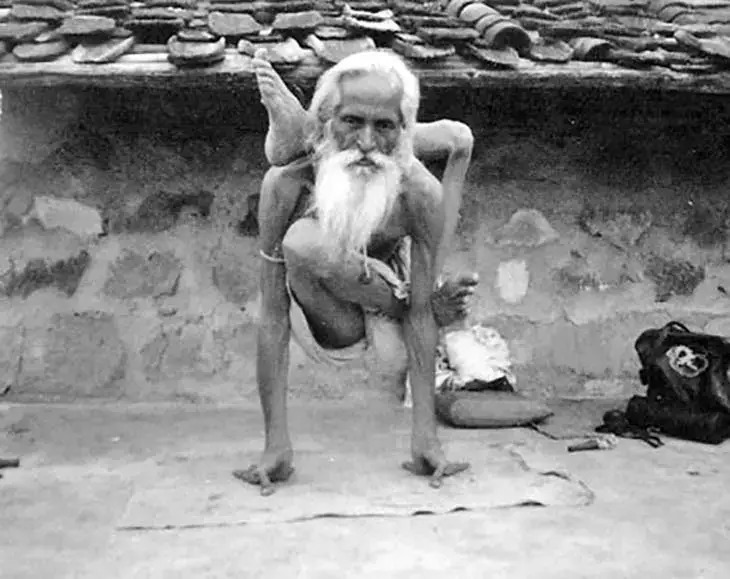
Top 11 Hard Yoga Poses for Advanced Yogis
Advancing into any of these poses requires a significant amount of preparation and guidance from an experienced yoga practitioner. Find a teacher who is willing to guide you through the process and encourage your advancement while also preventing any major injuries.
As always, it’s best to master the basics before diving into any advanced asanas. Don’t attempt anything you don’t feel comfortable with.
1. Handstand Scorpion Pose (Taraksvasana)
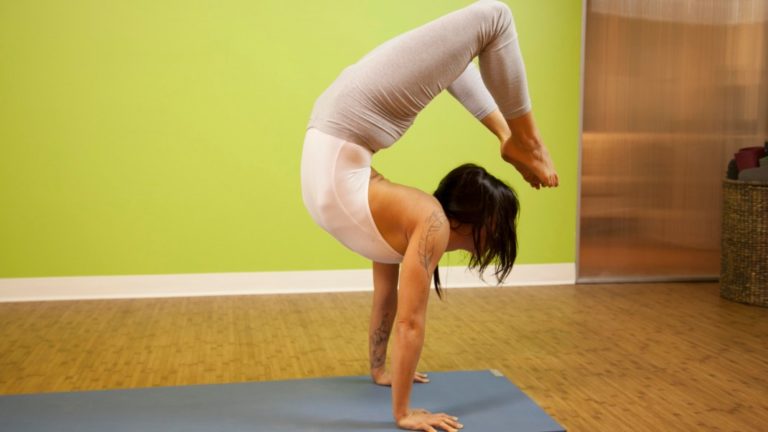
Inspired by the power and intimidation of a striking scorpion, this is considered one of the most difficult yoga postures in history. Handstand Scorpion Pose is one of the fullest expressions of human strength, flexibility, and balance.
A rock-solid handstand and a backbend are the foundational skills for this pose. Once these are mastered separately and the body is thoroughly warmed up, getting into the pose is actually quite simple (but not easy!)
How to Do Handstand Scorpion Pose (Taraksvasana)
Begin by balancing on your handstand, engaging the core, and breathing very deeply. Slowly, begin arching your back and stretching your toes toward the top of your head. The chest will naturally shift backward and the head forward to recalibrate an equilibrium of balance.
In the full expression of Handstand Scorpion, the toes hover just above your head, and your gaze is shifted forward as the stomach and pelvis round backwards.
2. Forearm Scorpion (Vrischikasana)
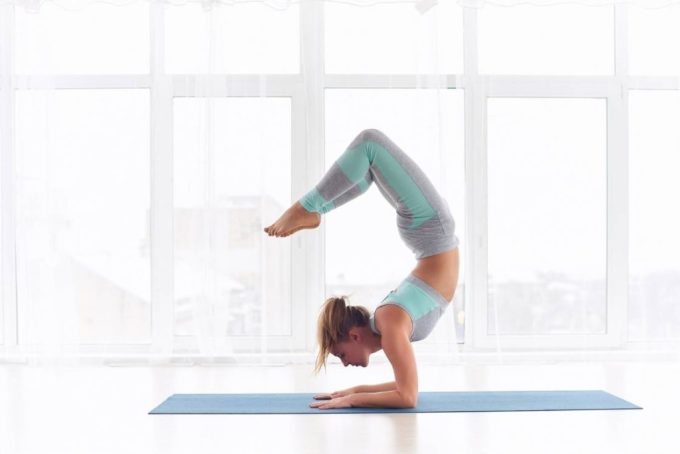
A slightly easier Scorpion variation, the forearm-balancing Vrischikasana pose still resembles a striking scorpion ready to sting its prey.
Because the feet land near the head with extreme flexibility and strength, the pose symbolizes the removal of negative emotions and blockages that may be preventing a yogi from reaching complete internal harmony.
How to Do Forearm Scorpion (Vrischikasana)
Begin in a downward dog and shift your elbows down with your forearms parallel. Walk toward your elbows as far as possible, then exhale and use your core strength to lift into a forearm inversion (like a handstand, but on your forearms). Find balance with your chest and legs stretched upwards in alignment.
Exhale to bend your knees and point your toes, beginning to draw your head and neck upward in an arch. Keep lowering your feet toward the crown of your head as you breathe, allowing your back to bend into a complete arc.
The easiest way to exit this pose is to slowly bring your legs to the floor in front of your head and then adjust backwards into a wheel/backbend pose.
3. Crow Pose (Bakasana)
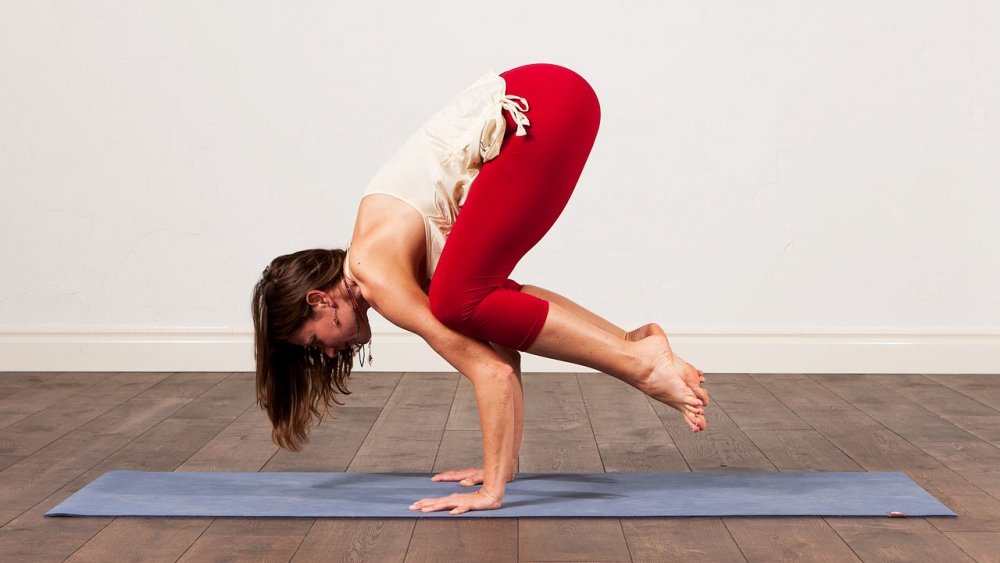
While not nearly as challenging as Scorpion Pose, Crow Pose is an advanced arm balance that requires significant core strength. It is a popular ending posture for intermediate-level vinyasa and hot yoga classes. The most important thing to remember about Crow Pose is the flexibility needed to bring the knees high enough up on the back of the arms. It is also essential to hold your weight evenly throughout your hands, especially in the knuckles of the thumb and forefinger.
How to Do Crow Pose (Bakasana)
Begin by strengthening your upper body through mastering Chaturanga and prop-supported Crow Pose with a block under the toes. Once you feel strong enough to attempt it, consider placing a blanket or pillow below your forehead in case you fall.
Start in a squatting position. Stand up on your tiptoes and hinge forward, placing your hands firmly on the floor in front of you and pushing your knees into the area just below your armpits on the back of your arm. Slowly move your gaze forward and, on an inhale, begin shifting your body weight toward the front as you slowly lift one foot from the ground.
Major core engagement is required to eventually reach the full expression of the pose, where the knees are balancing on the back of your arms. Breathe deeply and don’t be afraid to laugh, fall out, and try again!
4. One-Legged Crane Pose (Eka Pada Bakasana)
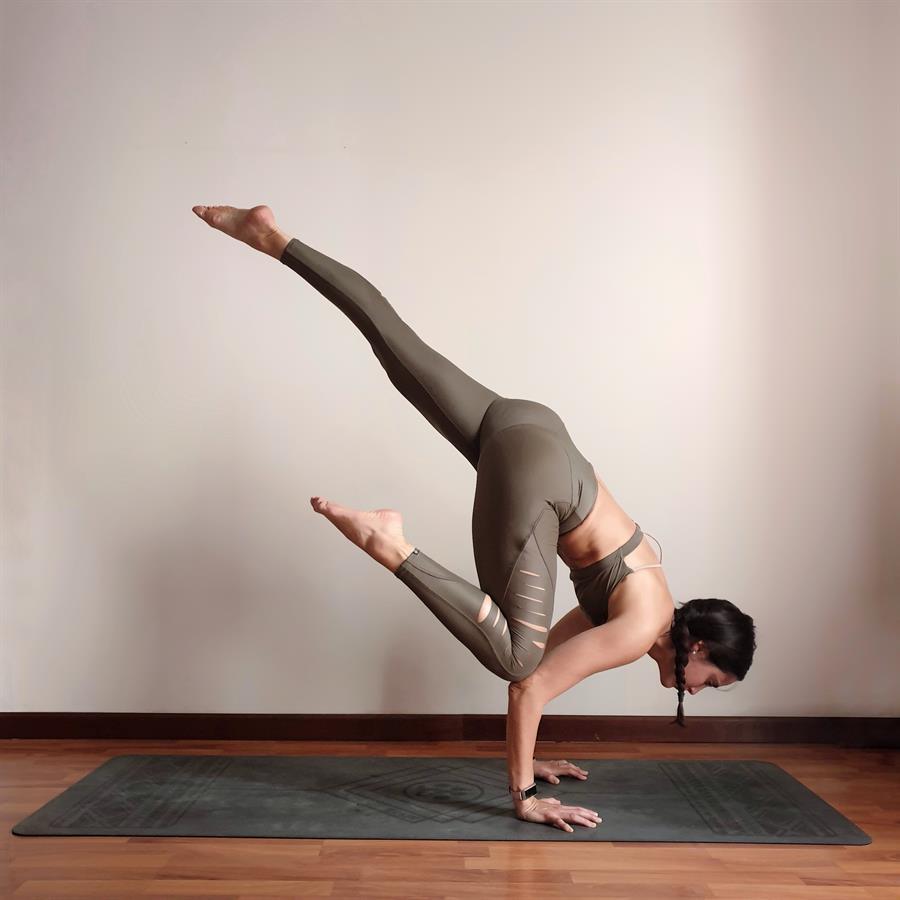
Crow Pose is a walk in the park compared to Eka Pada Bakasana. A lot of yogis fear this pose (for good reason: it’s really freakin’ hard!) But with enough persistence and patience, anyone can master this advanced yoga pose, especially if they are beginning with a super-solid Crow Pose in their practice.
How to Do One-Legged Crane Pose (Eka Pada Bakasana)
Start in a strong Crow Pose that can be held for at least 1 minute. Begin practicing asymmetric balance by drawing the thighs together and moving them over to the side so one arm is in between your knees. Once you are comfortable with this, begin straightening the back leg upward. Alternatively, you can try hopping into the pose from a forward fold.
This is super challenging and requires a lot of adjustments and practice, preferably with the help of an experienced yoga teacher. Confidence, breath, and core engagement are key. Keep the hips high and every muscle flexed.
5. Lotus Pose (Padmasana)
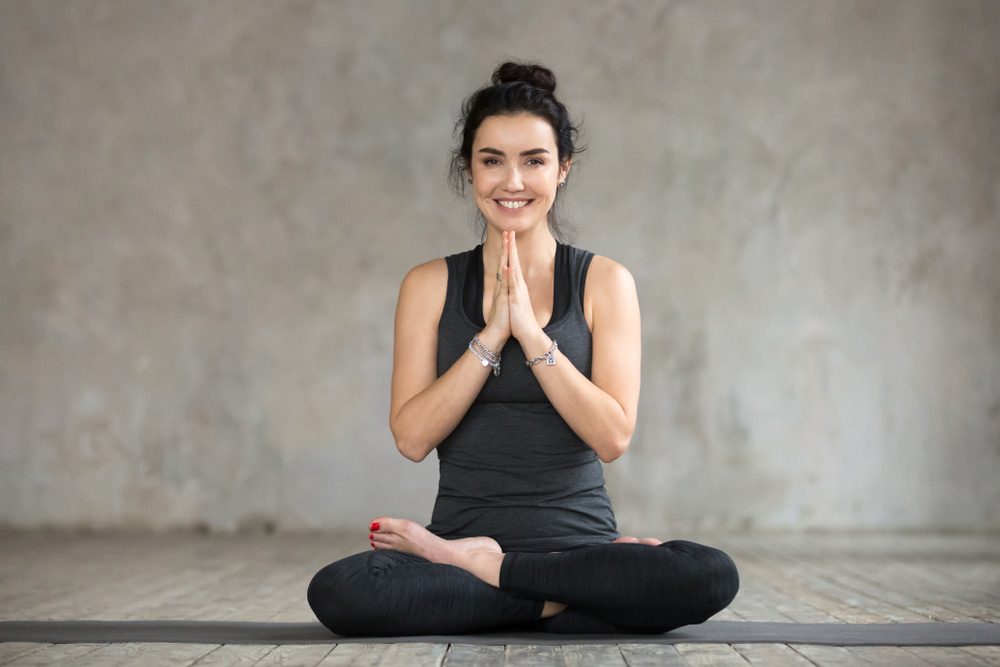
Fortunately, there are some advanced yoga poses that don’t require inverted balancing at all. The Lotus Pose appears easy, but it takes a lot of hip flexibility to reach the full expression. This pretzel-like seated asana is all about increasing circulation and freeing any stagnant energy held in the hips. After all, ancient yoga lore says we hold a lot of our emotional baggage in the hip flexors. A hip-opening Vinyasa flow and several minutes of holding Pigeon Pose and Tree Pose are excellent warmups to lead into a Lotus position.
How to do Lotus Pose (Padmasana)
After warming up the hips and legs, sit in a cross-legged position with your spine long. Grab your right ankle and rotate the foot so it is facing up towards you. Place the ankle as high on the left hip as possible, feeling a full external rotation in the right hip and knee.
Once you are comfortable in this Half Lotus, grasp the left ankle and bring it over the right thigh to settle into the right hip. Let your knees sink towards the floor, keeping the abs engaged and the lumbar spine straight. Breathe.
6. Lotus Headstand (Sirsasana Li Padmasana)
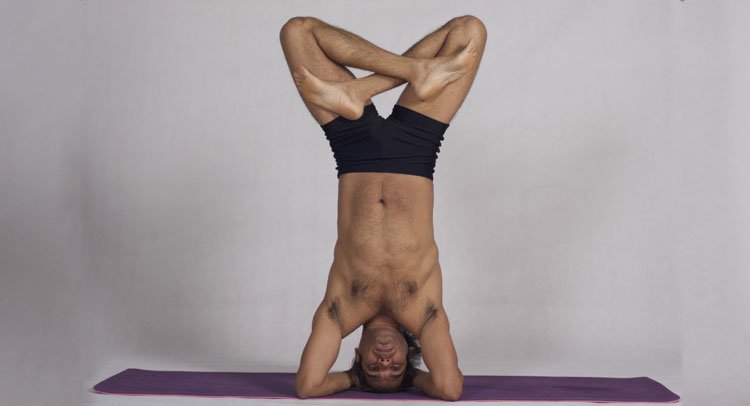
Combining lotus legs with inversions helps spice things up for fun photo opportunities and a deep stretch. Of course, you cannot achieve this advanced pose until you have mastered both Headstand (Sirsasana) and Lotus Pose (Padmasana) on your own. When you’re ready to combine the two,
How to Do Lotus Headstand (Sirsasana Li Padmasana)
Begin in a table-top position. Come down to your elbows and place the top of your head on the ground. Clasp your hands together at the crown of your head with your elbows out to the side as if in a triangle. Straighten your legs and begin walking your feet toward your face, using your core to lift into a headstand.
Once you gain your balance, spread your legs wide into a “V” and prepare to enter Lotus just as you would in a seated position. Slowly bend one knee and place the top of your foot on your opposite hip bone. Then, bend the other knee and wiggle the foot back and forth to move it up your thigh, reaching toward the opposite hip. Sometimes this takes a little bit of adjusting and practice. Squeeze the glutes to press your hips forward and open the hips.
You have the option to keep the hips at the right ankle (lotus legs facing downward) or to lift the hips up and flatten the back (lotus legs facing forward). Either way, you are reaping tremendous benefits for your balance, flexibility, circulation, and strength.
7. Eight-Angle Pose (Astavakrasana)
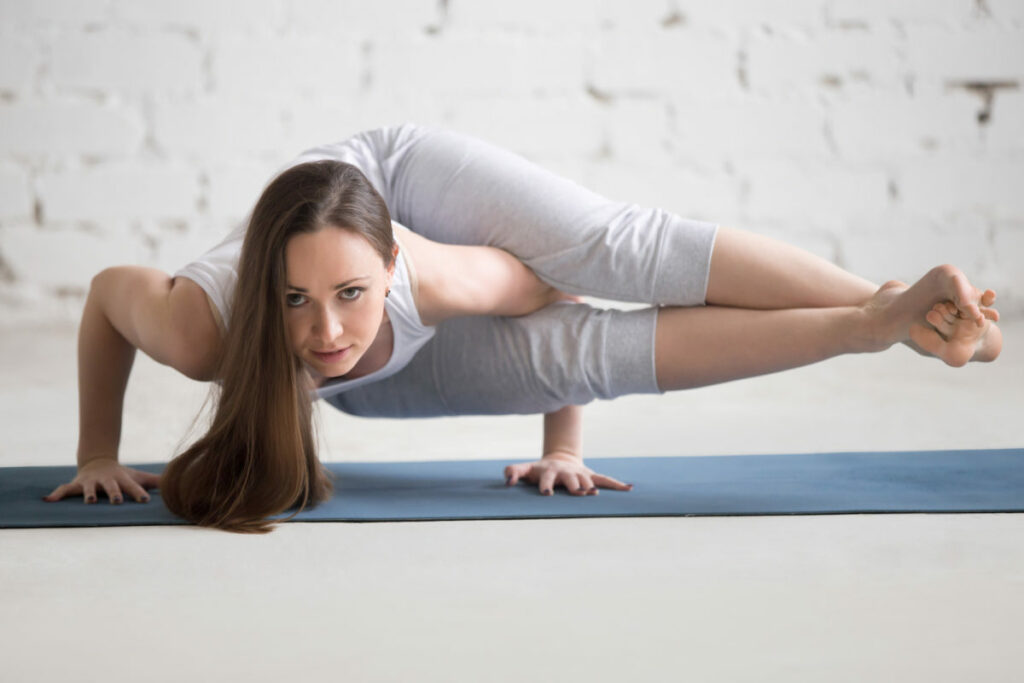
This pose is named after a famous yogi sage called Astavakra, from the Sanskrit words “Asta” (eight) and “Vakra” (bent). This sage was born with 8 bends in his body, essentially a birth defect. But in spite of his ailments, he was able to read Vedic scriptures and eventually achieve enlightenment.
This pose is a testament to overcoming any challenge that life throws at you. It also provides excellent benefits to your body by strengthening your wrists and upper body, toning your core, working the inner thighs, and aiding in toxin elimination.
How to Do Eight Angle Pose (Astavakrasana)
It may take several months to prepare for Eight Angle Pose. A solid Chaturanga, Handstand, Crow Pose, and general upper back strength are essential. When you are ready to start practicing, begin in Staff Pose (seated with your legs outstretched in front of you). Bend your right knee out to the side and thread your right arm through the leg so the knee is on your shoulder. Press the leg into the arm to stabilize.
Next, tilt slightly forward and place your hands on the mat on each side of your hips. Engage your core and press into the floor to lift your hips and left leg off the ground. Next, intertwine your ankles together and begin to adjust your upper body forward as you straighten the legs out to the side and bend the arms. Your legs will ultimately press into each side of your right arm as you balance.
8. Yoga Sleeping Pose (Yoganidrasana)
For the full-on pretzel yogis, this legs-behind-the-head pose is not nearly as easy as its name makes it sound. Nonetheless, the benefits for hip opening, sleep, de-stressing, and relaxation are tremendous for those who are willing to try.
This pose targets nearly every joint and tendon in the body, improving digestion, circulation, and mental health. It’s directly associated with the Sacral chakra, which is located below the navel and is closely associated with emotional well-being and groundedness. Once a yogi reaches the full expression of this pose, they should be able to “sleep” in a meditative relaxed state (but don’t worry, we’re not at that level yet either!)
Contrary to most advanced yoga poses, this asana is almost pure flexibility. Be sure that your body is thoroughly warmed up and extremely limber before even attempting Yoganidrasana.
How to Do Yoga Sleeping Pose (Yoganidrasana)
Begin laying flat on your back in Savasana with warmed, deeply stretched limbs. On an inhale, bend your knees and grab both feet as if in a reclined “butterfly” position. Externally rotate your hips to bring the feet to the back of the head. Cross your ankles together.
Gently lift your head and shoulders off the floor to place your ankles under your neck while simultaneously pressing your shoulders into the back of your knees. Place your hands in a prayer position or cross them beneath your tailbone.
9. Formidable Face Pose (Gandha Bherundasana)
This advanced yoga pose strengthens your upper body, back, abs, and spine. It is known to improve both focus and balance. Plus, it looks incredible in photos! This one is best avoided if you have neck, wrist, or shoulder pain of any kind. It also requires a mastery of general handstands before attempting.
How to do Formidable Face Pose (Gandha Bherundasana)
Start in a table top position with both hands and knees stacked shoulder-width apart. On an inhale, lift the left leg straight back. On an exhale, engage your core and bend your arms as if entering a Chaturanga. Gently place your chin on the floor, gazing downward. At the same time, the left leg will float upward and the right knee will bend. Your shoulders should press away from your neck.
With control, lift your left leg and engage. Use a gentle kick to press of the ball of your right foot and join the other leg as they reach toward the sky. Squeeze the inner thighs and glutes together. Every muscle in your body should be engaged as you breathe. Your elbows should press into your sides and the weight should be balanced across your hands (not in your chin!). Exiting is as far easier than entering: just float the toes back to the floor and land in a Chaturanga or tabletop position.
10. One Handed Tree Pose (Eka Hasta Vrksasana)
Yoga inversions are challenging and inspiring, but balancing your whole body on one hand? That’s the next level! One Handed Tree Pose is an incredible advanced yoga pose that includes a wide-legged handstand balancing on one hand (the trunk of the tree). As the legs float out in a “V” shape, they resemble the branches of a proud tree. This pose requires major wrist, arm, shoulder, and core strength.
How to Do One-Handed Tree Pose (Eka Hasta Vrksasana)
Starting in a downward dog, press into the hands and walk your feet toward your face until you float or hop into your handstand position. Intermediate yogis can practice against a wall or with a block before entering the full pose expression.
Next, spread the legs wide into a “V-shape” and begin shifting your weight into the right arm and shoulder. This is where a block comes in handy because you can practice asymmetrical balance without risking completely falling on your right arm. Use a spot or an experienced teacher to help you out.
As the weight shifts into the standing arm, press with all your might into the floor, keeping your arms, core, back, and legs fully engaged. Your shoulder should be pressed away from the neck to avoid collapsing into the supporting arm. Eventually, ease up your left hand to reach toward the left leg. Breathe deeply and exit by returning to a standard handstand.
11. Forearm Hollow Back Pose (Pincha Mayurasana)
One of the most beautifully photographable poses, Pincha Mayurasana is a gorgeous feminine expression (don’t worry guys, you can do it too). This asana is inspired by the natural elegance of a peacock. The “hollow back” position stretches the back, opens the heart, and challenges your balance while calming your mind. It is incredible for anyone who struggles with anxiety or stress.
How to Do Forearm Hollow Back Pose (Pincha Mayurasana)
Peacock pose is a forearm inversion that requires a mastery of stability and focus. Warm up with your standard Headstands, Crow Pose, Forearm Stands, and Backbends.
Begin in a table top position, bringing your forearms down to the mat and clasping your hands together. Lift your hips into a Dolphin Pose and lengthen one leg up toward the sky. Lightly hop or bend the second leg to meet the first so your body is in a perfectly parallel Forearm Stand.
Begin pressing your chest toward the back of the mat and bending your knees. The glutes will slowly sit backward as your stomach and chest push forward. Bring one bent leg farther down with the toe reaching toward the floor. The other bent shin remains parallel to the ground with the toes pointed. Exhale and release by cascading backwards into a Wheel Pose or kicking forwards into Dolphin.
Closing Thoughts
For thousands of years, yogis have achieved some fascinating feats of beauty, strength, and focus. If old Indian sages were able to master these advanced yoga poses, then you are certainly capable of them, too! Advancing in the most difficult yoga poses on the planet requires confidence, persistence, and a willingness to fail and keep getting back up to try again.
Whether you’re seeking inspiration, entertainment, or a lofty goal to work towards, it’s always beneficial to stretch the limits of what you believe is possible. These asanas remind us of the profound life lessons that yoga can gift us both on and off the mat.
Have you mastered any of these hard yoga poses? Submit a photo to be featured!
Namaste!
FAQs
How do you master advanced yoga poses?
Mastering advanced yoga poses requires extreme dedication, focus, and persistence. You have to be willing to fail and keep trying, day after day. Most advanced yoga poses can be achieved with a few weeks or months of dedicated daily practice. The easiest way to begin is by mastering the basics and strengthening your core: regularly practice Plank Pose, Chaturanga, Boat Pose, Crow Pose, Headstand, Handstand, and Backbends.
What is the most difficult yoga pose?
Handstand Scorpion Pose (Taraksvasana) and Eight Angle Pose (Astavakrasana) are considered two of the most difficult yoga poses on the planet. A mastery of arm balance, focus, flexibility, stability, and major shoulder and wrist strength are required to achieve them. But the rewards for working toward these poses are tremendous: improved core strength, arm strength, mental wellness, relaxation, and mental clarity are just a few of the benefits of these advanced yoga poses.

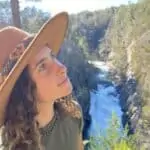

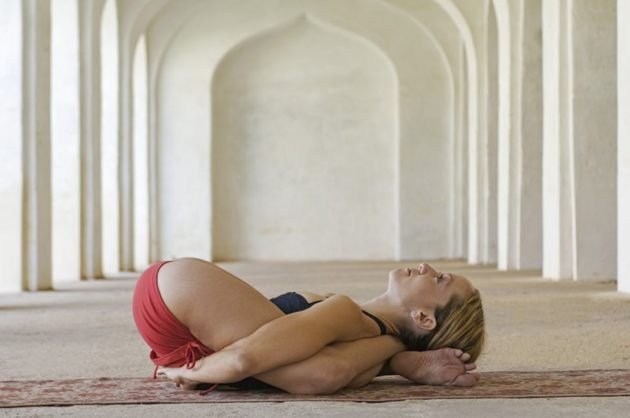
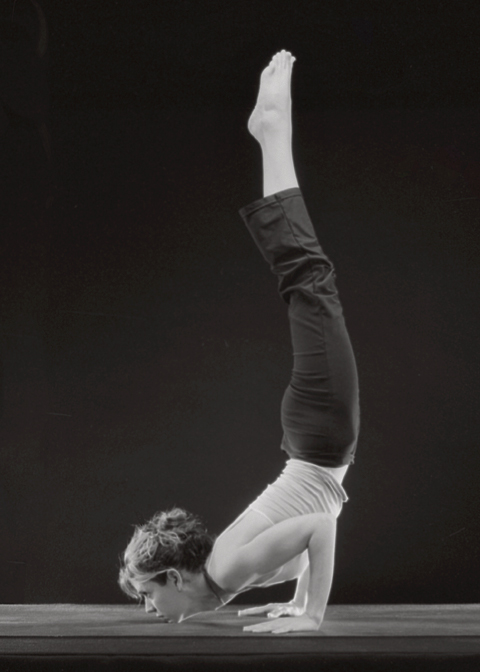
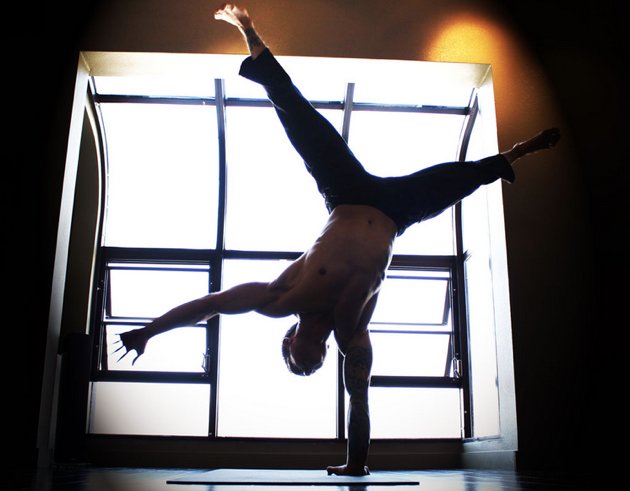
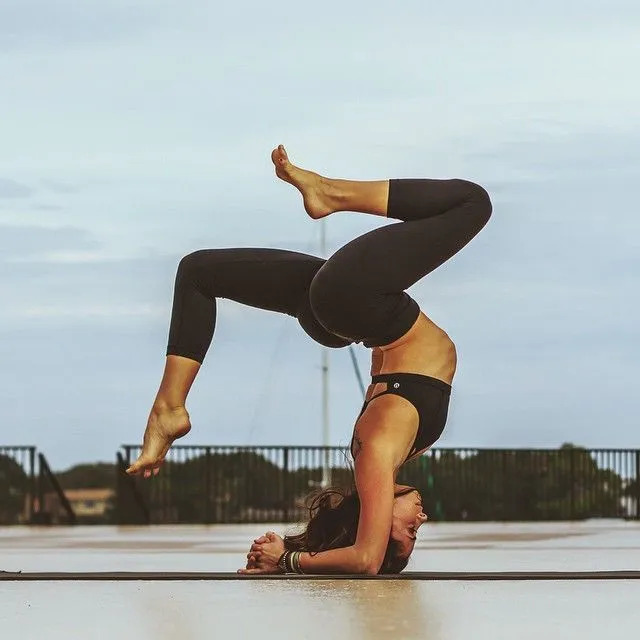
This post is really inspiring! I’m a hardcore yogi, and I’ve been trying out some of these poses, and they’re really challenging!